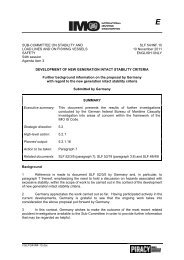Examination of the intact stability and the seakeeping behaviour
Examination of the intact stability and the seakeeping behaviour
Examination of the intact stability and the seakeeping behaviour
Create successful ePaper yourself
Turn your PDF publications into a flip-book with our unique Google optimized e-Paper software.
1 Introduction<br />
In <strong>the</strong> years 2008/2009 <strong>the</strong> world economic crisis caused a reduction in <strong>the</strong> number <strong>of</strong> transported<br />
TEU, due to a signicant decrease in transported goods. Consequently a great number <strong>of</strong> container<br />
vessels had been laid up or were forced to operate with a small amount <strong>of</strong> cargo on board.<br />
In this loading condition container vessels have a very high <strong>stability</strong>. In many cases <strong>the</strong>ir vertical<br />
center <strong>of</strong> gravity is even located below <strong>the</strong> lightship condition's coordinate. This is due to large<br />
amounts <strong>of</strong> ballast water in wing <strong>and</strong> double bottom tanks as well as no or only a small amount<br />
<strong>of</strong> cargo located at cargo hold bottom. The high amount <strong>of</strong> ballast water is needed to obtain an<br />
adequate hull <strong>and</strong> propeller immersion as well as a limitation <strong>of</strong> <strong>the</strong> longitudinal bending moments<br />
within <strong>the</strong> hull structure. In <strong>the</strong> typical loading conditions with higher amounts <strong>of</strong> cargo,<br />
less ballast water is needed <strong>and</strong> <strong>the</strong> <strong>stability</strong> is lower. Under <strong>the</strong> described circumstances, several<br />
accidents have happened to container vessels during <strong>the</strong> last years. The accidents caused not only<br />
severe damages on ships but also heavily injured <strong>and</strong> even killed crew members. They have been<br />
thrown through <strong>the</strong> bridge due to high transversal accelerations caused by heavy roll motions<br />
<strong>of</strong> <strong>the</strong> ship. This highlights, that modern container ship designs face some problems concerning<br />
insucient <strong>seakeeping</strong> behavior. Since several accidents have happened to ships sailing under<br />
German ag, <strong>the</strong> BSU analyzed <strong>the</strong>m by default. For three <strong>of</strong> <strong>the</strong> accidents, <strong>the</strong> <strong>seakeeping</strong><br />
behavior has been examined in detail by order <strong>of</strong> <strong>the</strong> BSU at <strong>the</strong> institute <strong>of</strong> ship design<br />
<strong>and</strong> ship safety at <strong>the</strong> Hamburg University <strong>of</strong> Technology (TUHH) [1][2][3]. This<br />
<strong>the</strong>sis shall examine <strong>the</strong> <strong>seakeeping</strong> behavior <strong>of</strong> several typical container vessels in equivalent<br />
environmental conditions.<br />
1.1 Key data <strong>of</strong> <strong>the</strong> three examined accidents<br />
The examinations revealed signicant parallels between <strong>the</strong> accidents. They all happened under<br />
comparable environmental <strong>and</strong> loading conditions.<br />
ˆ All ships followed <strong>the</strong> st<strong>and</strong>ard procedure for heavy wea<strong>the</strong>r. This means, that <strong>the</strong>y head<br />
into <strong>the</strong> sea at slow speeds to minimize <strong>the</strong> risk <strong>of</strong> damaging <strong>the</strong> ship's bow structure due<br />
to high slamming forces <strong>and</strong> green water on deck.<br />
ˆ All ships encountered large rolling angles <strong>of</strong> more than 30 ◦ .<br />
ˆ Due to <strong>the</strong> excessive <strong>stability</strong> <strong>and</strong> <strong>the</strong> <strong>the</strong>refore short roll periods <strong>of</strong> <strong>the</strong> ships, <strong>the</strong> high roll<br />
angles resulted in transversal accelerations <strong>of</strong> up to 14 m /s 2 .<br />
In <strong>the</strong> following, an overview <strong>of</strong> <strong>the</strong> environmental conditions <strong>and</strong> several ship data for <strong>the</strong><br />
three examined accidents is given. More detailed information about <strong>the</strong> accidents <strong>and</strong> <strong>the</strong>ir<br />
circumstances may be extracted from <strong>the</strong> respective investigation reports.<br />
1.1.1 Accident <strong>of</strong> <strong>the</strong> CMS Chicago Express [1]<br />
ˆ The accident happened on September 24th, 2008 during heavy wea<strong>the</strong>r in <strong>the</strong> South<br />
China Sea near Hong Kong.<br />
1

















